|


|
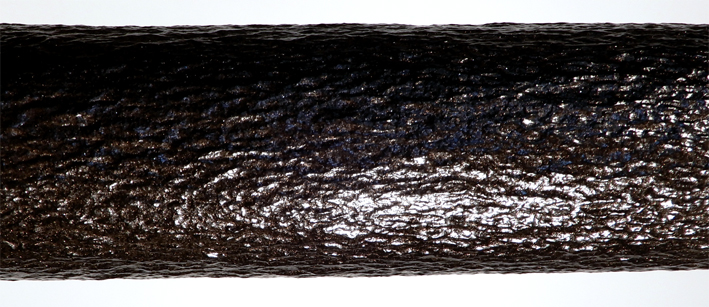
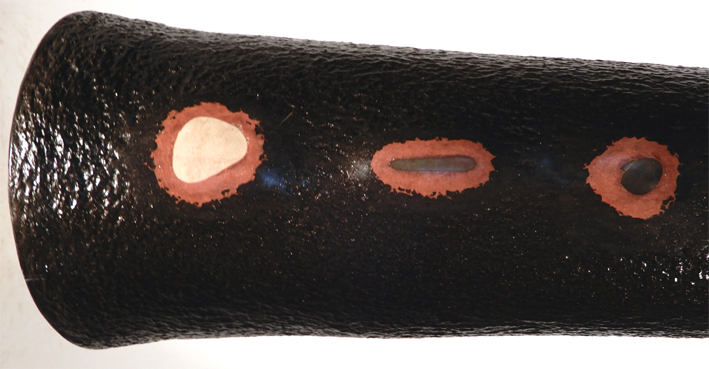
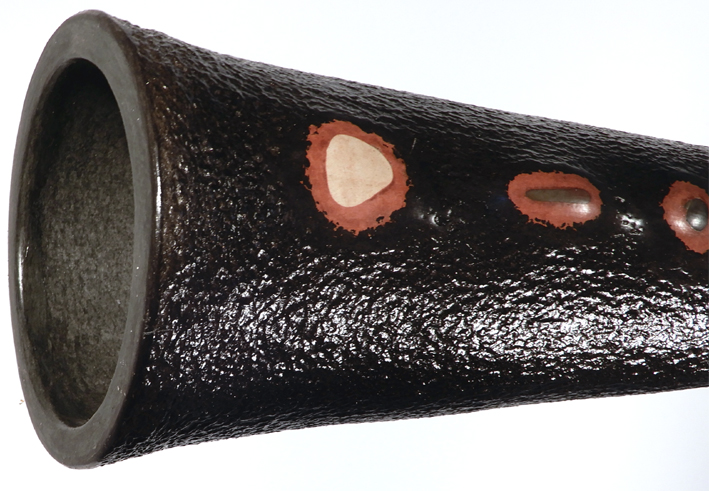
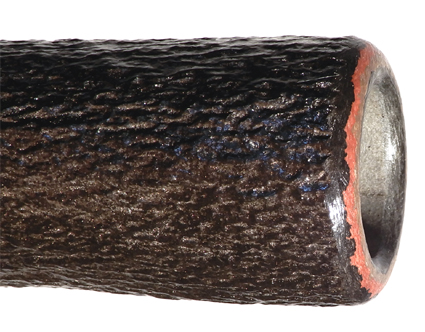 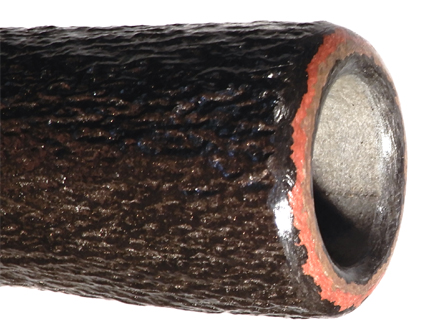
Beschreibung des Didgeridoos:
Description in English is following the German text.
Das Didgeridoo Dg490
ist ein etwas konisches Instrument
mit einem ersten Overblow auf einem Ton über der Oktave.
Mit 4,1 kg stellt es ein sehr stabiles massives Didgeridoo dar,
dessen Wandstärke die tonalen Eigenschaften wenig beeinflusst.
Das Mundstück ist mit 32mm Innendurchmesser etwas breiter,
die Wandstärke am Mundstück mit 9mm ist abgerundet und
bietet eine breite Kontaktfläche.
Das Didgeridoo hat einen für diese Bauart typischen starken
obertonreichen Basiston. Es hat also eine akzeptabel gute Impedanz,
Resonanzwiderstand, oder einen guten "Gegendruck" wie
das von Insidern beschrieben wird. Die mächtige konische,
sich erst im Bereich des Bell dann doch stärker erweiternde
Form gibt einen lauten starken Grundton.
Dg 490 ist ein Instrument dessen Eigenschaften entstammen der
frühen Formennummer F7. Das ist eine Form die sich als altbewährte
gelungene aus einer Intuition konstruierte Idee aus den Anfängen
meiner Tätigkeit mit Hempstone erhalten hat.
Die Stimmlage erlaubt eine Verwendung für einen Kammerton
A4 = 432Hz, der Grundton wurde auf dieser Basis auf den Ton D2
eingestimmt.
In dem mit Holzkohle und Eisenoxid schwarz gefärbtem Material
Hempstone ist eine rote Zwischenschicht gefärbt mit gebrannter
Siena eingefügt, welche nur an der Schnittstelle beim Mundstück
und bei den Einlagen mit drei Steinen aus dem Lafnitz Fluss zu
sehen ist. Man könnte die schwarze Oberfläche mit Gravuren
versehen, welche bis in diese rote Schicht reichen und sie so
stellenweise freilegen.
Die genauen Tonverhältnisse wurden bei etwa Raumtemperatur
am einige Minuten lang warm gespielten Instrument gemessen. Ich
gebe zu bedenken, dass die Angaben in Klammer Tonbereiche kennzeichen,
wobei die Anatomie und die eingesetzte Lippenspannung der Menschen
den Bereich variieren können. Dieser Effekt zeigt sich stärker
bei Didgeridoos mit eher zylindrischer oder schmaler Mensur als
bei stark konischen Instrumenten mit weit offenem Bell.
Zur Darstellung der Tonhöhen verwende ich die international
übliche englische Scheibweise: Grossbuchstabe mit Ziffer,
z.B.: A1 ist 55 Hz Die Angaben beziehen sich meist auf den Kammerton
A4= 440Hz. Für Instrumente wie dieses Dg 490 die auf Basis
Kammerton A= 432 Hz konstruiert sind gebe ich die korrigierte
Skala zusätzlich an.
Angaben der Abweichungen und der durch Veränderung der Lippenspannung
spielbaren Bereiche sind in Klammer in Cent angegeben, ein Halbton
wird geteilt in 100 Cent, eine Oktave wird geteilt in 1200 Cent.
Der Grundton und die Overblows sind durch Schrägstriche getrennt.
Töne für A=440: D2-30 (Bn1 bis D+10) // E3-20 (E3-50
bis E3+5) / Bn3-20 (Bn3-40 bis Bn3+10) / D4+-0 / E4-10 / G#4 +5
Töne für A=432: D2+-0 (Bn1 bis D+40) // E3+10 (E3-20
bis E3+40) / Bn3+10 (Bn3-10 bis Bn3+40) / D4+30 / E4+20 / G#4
+35
Description of the didgeridoo:
The didgeridoo Dg490 is a somewhat conical instrument with
a first overblow on a note above the octave.
With 4.1 kg it represents a very stable solid didgeridoo, whose
solid wall thickness has little influence on the tonal properties.
The mouthpiece is a bit wider with 32mm inner diameter, the wall
thickness at the mouthpiece with 9mm is rounded off and offers
a wide contact area.
The didgeridoo has a strong base tone rich in overtones, typical
for this type of construction. So it has an acceptably good impedance,
resonance resistance, or a good "back pressure" as this is described
by insiders. The powerful conical shape, widening only in the
bell area, gives a loud strong fundamental tone.
Dg 490 is an instrument whose characteristics derive from the
early shape number F7. This is a shape that has been preserved
as a well-tried successful idea constructed from an intuition
from the beginnings of my work with Hempstone.
The tuning allows a use for a concert pitch A4 = 432Hz, the fundamental
was tuned on this basis to the tone D2.
In the Hempstone material dyed black with charcoal and iron oxide,
a red intermediate layer dyed with burnt sienna is inserted, which
can be seen only at the interface at the mouthpiece and round
the inlays with three stones from the Lafnitz River. Engravings
could be added to the black surface, reaching into this red layer,
exposing it in places.
The exact tonal ratios were measured at about room temperature
on the instrument played warm for a few minutes. I give to consider
that the indications in brackets mark tone ranges, whereby the
anatomy and the used lip tension of the people diverges very individually
and therefore deviations from the test results can be determined.
This effect is more apparent in didgeridoos with a more cylindrical
or narrow scale than in highly conical instruments with a wide
open bell.
For the representation of the pitches I use the internationally
common English notation: Capital letter with digit, e.g.: A1 is
55 Hz The indications mostly refer to the concert pitch A4= 440Hz.
For instruments like this Dg 490 which are constructed on the
basis of concert pitch A= 432 Hz I give the corrected scale additionally.
Indications of the deviations and the ranges playable by changing
the lip tension are given in cents in parentheses, a semitone
is divided into 100 cents, an octave is divided into 1200 cents.
The fundamental and the overblows are separated by slashes.
Keys for A=440: D2-30 (Bn1 bis D+10) // E3-20 (E3-50 bis E3+5)
/ Bn3-20 (Bn3-40 bis Bn3+10) / D4+-0 / E4-10 / G#4 +5
Keys for A=432: D2+-0 (Bn1 bis D+40) // E3+10 (E3-20 bis E3+40)
/ Bn3+10 (Bn3-10 bis Bn3+40) / D4+30 / E4+20 / G#4 +35
Dg490 Sound
sample 01
|
|
